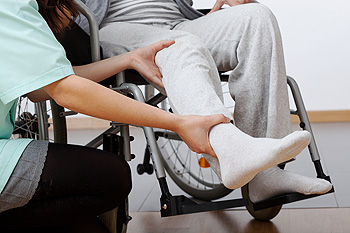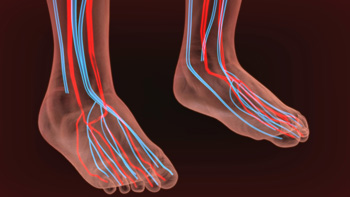Items filtered by date: February 2019
Is Foot Therapy Effective?
 If an injury should occur to the foot or ankle, foot therapy may be an avenue that is pursued to obtain mild relief. There are many foot conditions that would benefit from having physical therapy performed, and these may include plantar fasciitis, or foot and ankle stress fractures. Some patients find it helpful to use this form of therapy to aid in recovering from foot or ankle surgery, and it may help in regaining full range of motion. Additionally, flexibility and overall strength in the feet and ankles may improve when specific muscles are stretched. If you would like to know more about the benefits of foot therapy, please consult with a podiatrist who can properly guide you.
If an injury should occur to the foot or ankle, foot therapy may be an avenue that is pursued to obtain mild relief. There are many foot conditions that would benefit from having physical therapy performed, and these may include plantar fasciitis, or foot and ankle stress fractures. Some patients find it helpful to use this form of therapy to aid in recovering from foot or ankle surgery, and it may help in regaining full range of motion. Additionally, flexibility and overall strength in the feet and ankles may improve when specific muscles are stretched. If you would like to know more about the benefits of foot therapy, please consult with a podiatrist who can properly guide you.
Foot therapy is often necessary for those recovering from either foot deformities or foot injuries. If you have concerns regarding therapy, consult with Dr. Douglas Mckay from New Jersey . Our doctor can provide the care you need to keep you pain-free and on your feet.
Most Common Injuries
People who are active or athletes are prone to a variety of injuries. Therefore, it is often important to take part in physical therapy in order to quickly get back on the right track.
What to Do When Injured
Physical Therapy – This specialized treatment will focus on the affected area, speeding up recovery and the overall healing process. It is a proven method that has helped millions of people return from any injury.
During physical therapy you will undergo regimented training to get back into full form. Training is often very difficult, especially at first when the foot feels weak. Physical therapy often involves:
Basic stretching and twisting exercises – getting the feet’s mobility and flexibility up.
Massaging – the therapist will massage the injured area in order to activate the muscles and relax them.
Strengthening Exercises – this allows the muscles in the affected area to regain their full strength, a vital step towards full recovery.
If you have any questions please feel free to contact one of our offices located in Caldwell, and Galloway, NJ . We offer the newest diagnostic tools and technology to treat your foot and ankle needs.
Causes of Poor Circulation
 The medical condition that is referred to as poor circulation can be an indication of health issues that may exist in the body. It may be caused by poor dietary habits or sitting for extended periods of time. Additional causes may consist of diabetes, peripheral artery disease (PAD), or blood clots in the legs. Many patients experience symptoms that are indicative of poor circulation, and these may include a lack of energy, feet that are cold the majority of the time, or a tingling or numbing sensation in the hands and feet. Other symptoms may consist of having a poor memory, a weakened immune system, or a loss of appetite. Research has indicated that maintaining a healthy diet and engaging in an exercise regime may be helpful in treating poor circulation. It’s important to drink plenty of fresh water daily, in addition to avoiding alcohol. If poor circulation is affecting your feet, it is suggested to speak to a podiatrist who can properly diagnose and treat this condition.
The medical condition that is referred to as poor circulation can be an indication of health issues that may exist in the body. It may be caused by poor dietary habits or sitting for extended periods of time. Additional causes may consist of diabetes, peripheral artery disease (PAD), or blood clots in the legs. Many patients experience symptoms that are indicative of poor circulation, and these may include a lack of energy, feet that are cold the majority of the time, or a tingling or numbing sensation in the hands and feet. Other symptoms may consist of having a poor memory, a weakened immune system, or a loss of appetite. Research has indicated that maintaining a healthy diet and engaging in an exercise regime may be helpful in treating poor circulation. It’s important to drink plenty of fresh water daily, in addition to avoiding alcohol. If poor circulation is affecting your feet, it is suggested to speak to a podiatrist who can properly diagnose and treat this condition.
Poor circulation is a serious condition and needs immediate medical attention. If you have any concerns with poor circulation in your feet contact Dr. Douglas Mckay of New Jersey . Our doctor will treat your foot and ankle needs.
Poor Circulation in the Feet
Poor blood circulation in the feet and legs is can be caused by peripheral artery disease (PAD), which is the result of a buildup of plaque in the arteries.
Plaque buildup or atherosclerosis results from excess calcium and cholesterol in the bloodstream. This can restrict the amount of blood which can flow through the arteries. Poor blood circulation in the feet and legs are sometimes caused by inflammation in the blood vessels, known as vasculitis.
Causes
Lack of oxygen and oxygen from poor blood circulation restricts muscle growth and development. It can also cause:
- Muscle pain, stiffness, or weakness
- Numbness or cramping in the legs
- Skin discoloration
- Slower nail & hair growth
- Erectile dysfunction
Those who have diabetes or smoke are at greatest risk for poor circulation, as are those who are over 50. If you have poor circulation in the feet and legs it may be caused by PAD and is important to make changes to your lifestyle in order to reduce risk of getting a heart attack or stroke. Exercise and maintaining a healthy lifestyle will dramatically improve conditions.
As always, see a podiatrist as he or she will assist in finding a regimen that suits you. A podiatrist can also prescribe you any needed medication.
If you have any questions please feel free to contact one of our offices located in Caldwell, and Galloway, NJ . We offer the newest diagnostic and treatment technologies for all your foot and ankle needs.
Ways to Ensure Your Children’s Feet Are Healthy
 Parents are naturally concerned for all parts of their children’s health, but it is easy to sometimes forget about children’s feet. Fortunately, there are some easy ways to make sure your children’s feet are staying as healthy as they should be. Keeping feet clean and dry helps to prevent bacterial and fungal infection. Good hygiene will assist in stopping conditions like athletes’ foot, that thrive in moisture, from developing. Cutting toenails straight across will help to prevent uncomfortable ingrown toenails and showing children this technique in their younger years will help them carry this habit into adulthood. Shoes that fit properly are also essential. Children’s feet are constantly growing, so it is important to get their feet measured when buying new shoes. Tight shoes put children at a higher risk for blisters, corns, calluses, and ingrown toenails, which can all become infected. If you would like additional information about how to care for your child’s feet, then it is recommended to speak with a podiatrist to learn more about children’s foot health.
Parents are naturally concerned for all parts of their children’s health, but it is easy to sometimes forget about children’s feet. Fortunately, there are some easy ways to make sure your children’s feet are staying as healthy as they should be. Keeping feet clean and dry helps to prevent bacterial and fungal infection. Good hygiene will assist in stopping conditions like athletes’ foot, that thrive in moisture, from developing. Cutting toenails straight across will help to prevent uncomfortable ingrown toenails and showing children this technique in their younger years will help them carry this habit into adulthood. Shoes that fit properly are also essential. Children’s feet are constantly growing, so it is important to get their feet measured when buying new shoes. Tight shoes put children at a higher risk for blisters, corns, calluses, and ingrown toenails, which can all become infected. If you would like additional information about how to care for your child’s feet, then it is recommended to speak with a podiatrist to learn more about children’s foot health.
The health of a child’s feet is vital to their overall well-being. If you have any questions regarding foot health, contact Dr. Douglas Mckay of New Jersey . Our doctor can provide the care you need to keep you pain-free and on your feet.
Tips for Keeping Children's Feet Healthy
- Make sure their shoes fit properly
- Look for any signs of in-toeing or out-toeing
- Check to see if they have Clubfoot (condition that affects your child’s foot and ankle, twisting the heel and toes inward) which is one of the most common nonmajor birth defects.
- Lightly cover your baby’s feet (Tight covers may keep your baby from moving their feet freely, and could prevent normal development)
- Allow your toddler to go shoeless (Shoes can be restricting for a young child’s foot)
- Cut toenails straight across to avoid ingrown toenails
- Keep your child’s foot clean and dry
- Cover cuts and scrapes. Wash any scratches with soap and water and cover them with a bandage until they’ve healed.
If you have any questions, please feel free to contact one of our offices located in Caldwell, and Galloway, NJ . We offer the newest diagnostic and treatment technologies for all your foot care needs.
Symptoms of Toenail Fungus
 If you notice the color of your toenail becoming white or yellow, you may have what is referred to as toenail fungus. It is the result of an infection that is caused by a fungus, and the first noticeable symptoms may be discoloration of the toenail. The nail may appear darker as the infection spreads, in addition to the texture becoming compromised. This may become apparent if the nail should begin to crumble which may cause the toenail to separate from the nail bed. This type of fungus lives and thrives in moist and warm environments, which may include shoes that are not made with breathable materials. Additionally, showers and surrounding areas, locker rooms, or public pools may be a breeding ground for this type of fungus to live, and it is advised to wear appropriate shoes while in these areas. It may be beneficial to wash and dry the feet frequently, change socks and shoes daily, and properly trim the toenails. If you are afflicted with toenail fungus, it is suggested to seek the counsel of a podiatrist who can properly treat this condition.
If you notice the color of your toenail becoming white or yellow, you may have what is referred to as toenail fungus. It is the result of an infection that is caused by a fungus, and the first noticeable symptoms may be discoloration of the toenail. The nail may appear darker as the infection spreads, in addition to the texture becoming compromised. This may become apparent if the nail should begin to crumble which may cause the toenail to separate from the nail bed. This type of fungus lives and thrives in moist and warm environments, which may include shoes that are not made with breathable materials. Additionally, showers and surrounding areas, locker rooms, or public pools may be a breeding ground for this type of fungus to live, and it is advised to wear appropriate shoes while in these areas. It may be beneficial to wash and dry the feet frequently, change socks and shoes daily, and properly trim the toenails. If you are afflicted with toenail fungus, it is suggested to seek the counsel of a podiatrist who can properly treat this condition.
For more information about treatment, contact Dr. Douglas Mckay of New Jersey . Our doctor can provide the care you need to keep you pain-free and on your feet.
Toenail Fungus Treatment
Toenail fungus is a condition that affects many people and can be especially hard to get rid of. Fortunately, there are several methods to go about treating and avoiding it.
Antifungals & Deterrence
Oral antifungal medicine has been shown to be effective in many cases. It is important to consult with a podiatrist to determine the proper regiment for you, or potentially explore other options.
Applying foot powder on the feet and shoes helps keep the feet free of moisture and sweat.
Sandals or open toed shoes – Wearing these will allow air movement and help keep feet dry. They also expose your feet to light, which fungus cannot tolerate. Socks with moisture wicking material also help as well.
If you have any questions please feel free to contact one of our offices located in Caldwell, and Galloway, NJ . We offer the newest diagnostic tools and technology to treat your foot and ankle needs.



